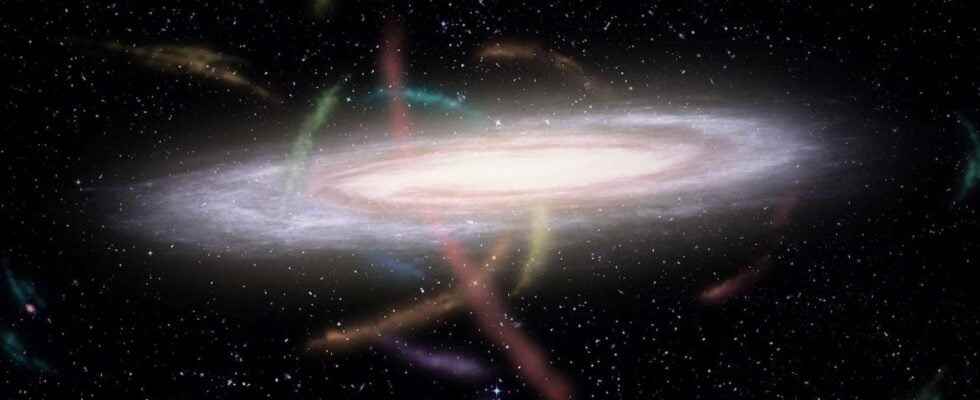The stellar currents that surround the Milky Way reveal a story in which it literally devoured a few of its fellow travelers. But they also deliver precious clues about the nature and distribution of the dark matter that surrounds our Galaxy.
You will also be interested
[EN VIDÉO] Dark matter lurks in the Milky Way’s halo Astronomers from Harvard University (United States) have mapped the outer halo of our Milky Way. The opportunity for them to deduce the presence of dark matter, this invisible substance supposed to constitute a large part of the mass of our Universe. Their simulation shows two areas of high density, in light blue. The smaller structure that appears on the map corresponds to the wake left by the passage in the region of the Large Magellanic Cloud, a satellite galaxy of ours. © Nasa / JPL-Caltech / NSF / R. Injured / N. Garavito-Camargo and G. Besla
“Think about your Christmas tree“, comments Geraint Lewis, researcher at the University of Sydney (Australia), in a University of Chicago press release (United States). It’s still a bit of seasons. “In the night, you only see the lights , but they give you an indication of its shape. “ And it is with the same state of mind as the researchers hope today to reveal the black matterthat surrounds the Milky Way. From the observation of the orbits of a dozen stellar currents in the halo of our Galaxy .
The first information on the black matter that these currents ofstars can bring to astronomerscomes from their speed . They were able to determine it using the telescopeAnglo-Australian from the Siding Spring Observatory (Australia). But that’s not all, since an analysis of the chemical composition of the stars that make up these currents also provides information on the nature of dark matter.
“We are seeing these streams being disrupted by the Milky Way’s gravitational pull, and eventually becoming part of the Milky Way,” said @UofT‘s @sazabi_li, who started this work at @CarnegieAstro. “This study gives us a snapshot of the Milky Way’s feeding habits.” pic.twitter.com/N8n44AP9QH
– Carnegie Science (@carnegiescience) January 11, 2022
Twelve star currents under the telescope’s eye
And this is the first time that astronomers have taken an interest not in a current of stars, but in “As many currents as possible”. Or a dozen, so far. A work made possible in particular thanks to the data of the European space mission Gaia . It indeed provides very precise measurements of the positions and movements of the stars in question. What hope to identify new trends. And finally flush out the dark matter that surrounds our Galaxy.
This work will also help to understand how the Milky Way was born in a Universealmost without relief. By regularly shredding and swallowing smaller star systems. “The most intriguing question about our ultimate origins”, according to Ting Li, a professor at the University of Toronto.
Interested in what you just read?
.
fs3
